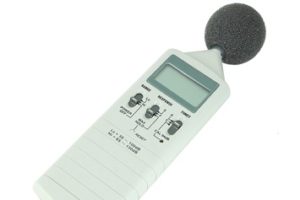When you create a workplace noise map using a sound level meter, you may get all of the information you need. However, if the results of your sound level measurements are borderline, or if other factors like variable noise or highly mobile workers are present, you may need to get a little more granular. You can do that using personal noise dosimetry.

Like any other form of personal exposure sampling, this type of measurement involves putting a dosimeter (in this case, a noise dosimeter) on the worker, who wears it throughout his or her shift.
Factors Affecting Dosimetry Readings
Many factors can affect the reading given by a personal dosimeter, so you must be vigilant about using this type of device. Personal dosimetry results can be thrown off by:
- Worker misuse. If you put the dosimeter on a worker’s jacket, and the worker takes the jacket off and leaves it on a chair for most of his shift, the reading will not accurately represent the worker’s exposure. Likewise, if the dosimeter is placed on the worker’s shirt, and the worker puts on a jacket that covers the dosimeter, the reading will be inaccurate.
- Improper use of the dosimeter. Always read the documentation that comes with the dosimeter, and make sure that it is fully charged, properly calibrated, and placed as near as possible to the worker’s ear.
- Artifacts. Dosimeters will pick up some events as “sounds” that are not sounds. If, for example, the dosimeter pickup is banged against an object—or even if the worker taps on the pickup with a finger—it will register this as sound, and the reading will be inaccurately high. Wind can also register as noise; windscreens are sometimes available to control this factor.
Interpreting the Results
Some personal dosimeters will give you a reading in A-weighted decibels (dBA) that is averaged over the sample time, while others will give you a percentage dose. These readings may have to be converted to a time-weighted average using the computations found in Appendix A of the occupational noise standard, which is available here.
Revisiting Your Noise Assessment
Noise levels in a workplace may be a constantly shifting target. A noise survey conducted today might show overall noise levels that are below the OSHA action level of 85 dBA. But if something changes in the workplace, it can affect the sound levels. Adding equipment will probably increase noise levels—unless you purchase it specifically to reduce them. But that’s not the only factor that can change sound levels. Sound levels can also change over time as equipment ages or if production processes change.
Periodic noise surveys can help you catch these changes. OSHA specifically requires employers to reassess workplace noise whenever a change in production, process, equipment, or controls increases noise exposures to the extent that:
- Additional employees may be exposed at or above the action level; or
- Hearing protection devices used in the workplace may no longer provide adequate noise reduction.
